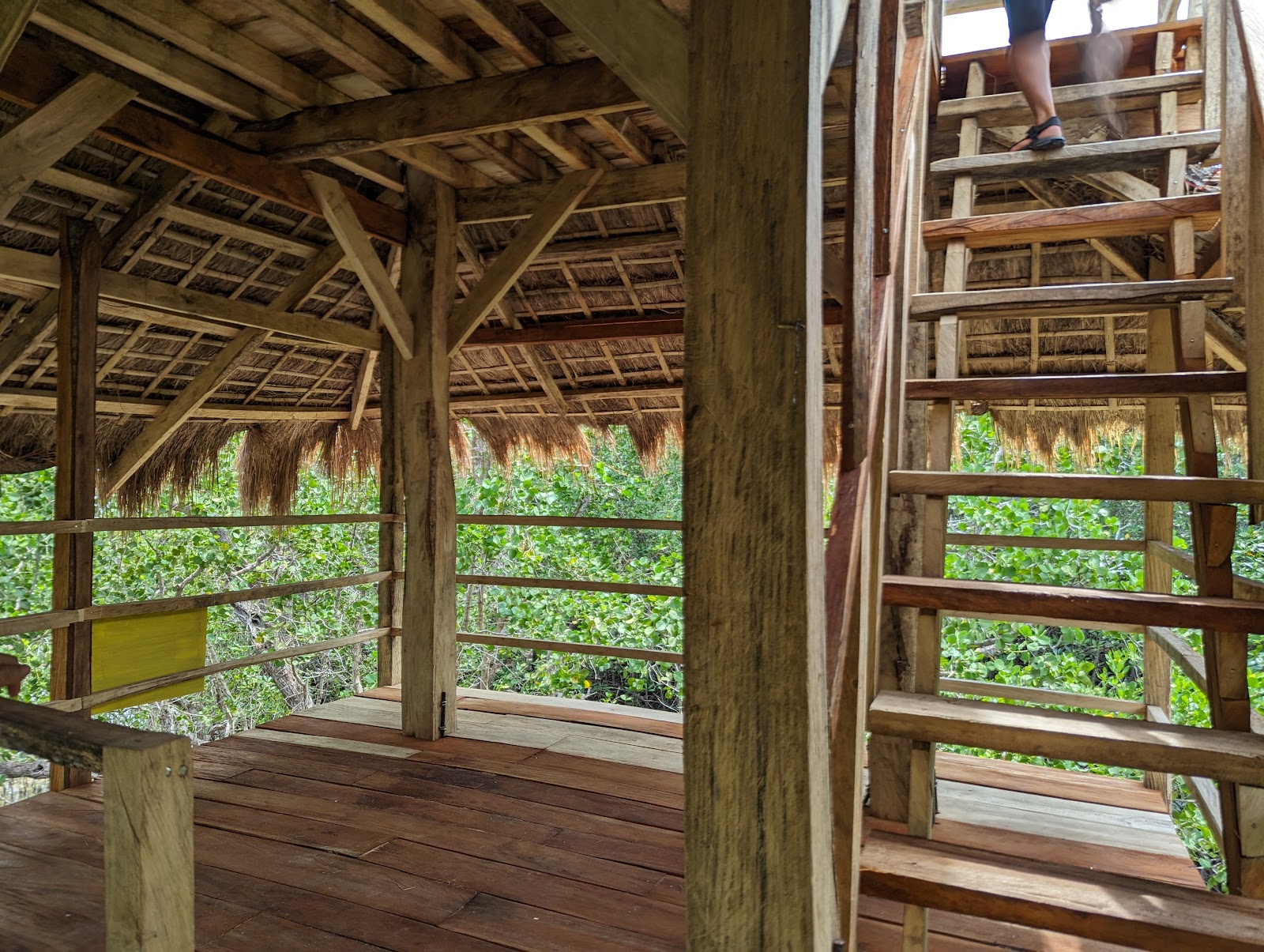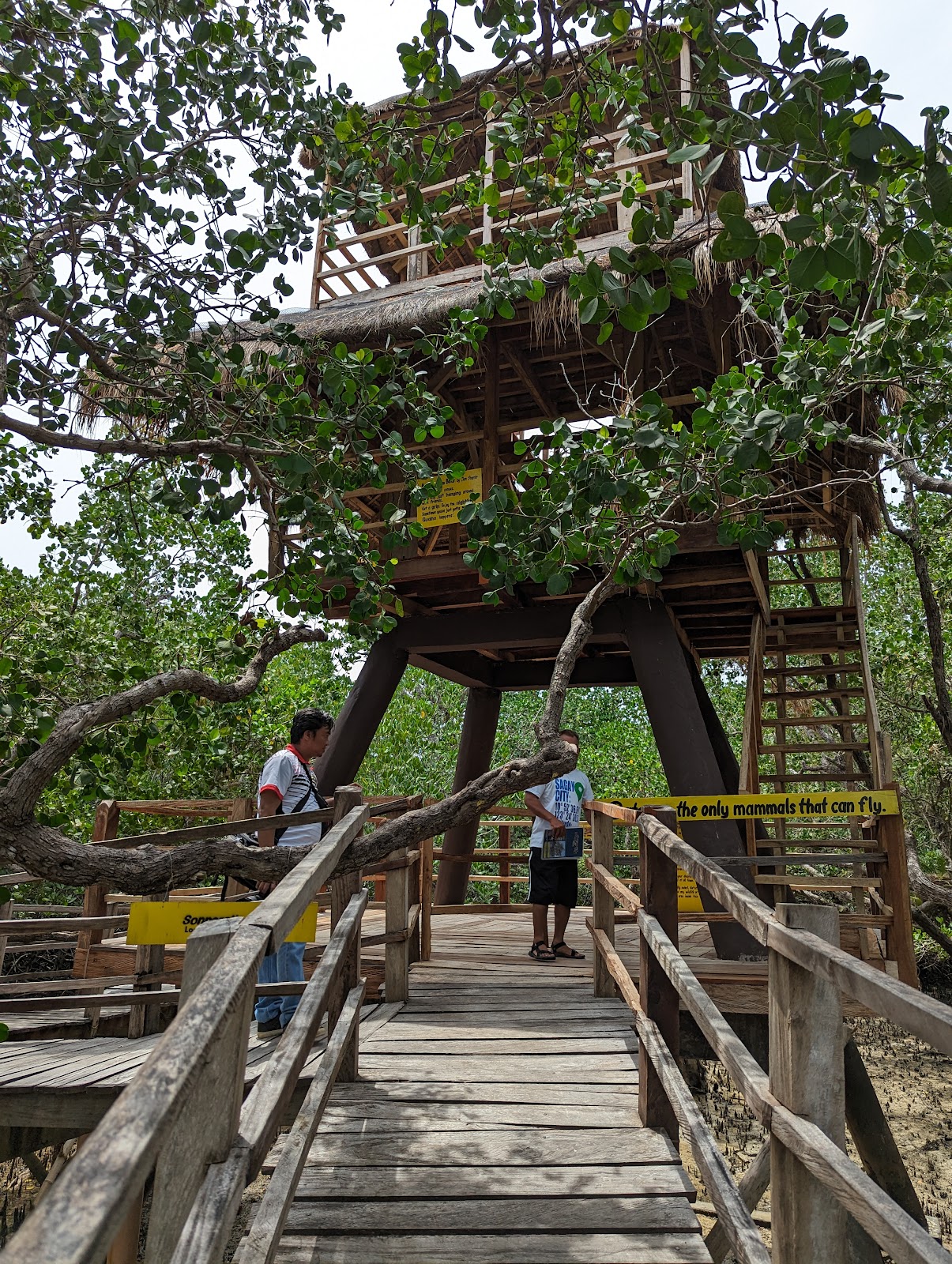 |
| Picturesque mangroves at the edge of Suyac Island reaching out to the sea. |
It is not very often that these phrases can be said in one breath without contradicting each other, but Suyac is making it work through their version of eco-tourism.
The 15.7-hectare Suyac Mangrove Reserve is part of the much larger 32,000-hectare Sagay Marine Reserve, which has no-take zones in some areas while prescribing allowable activities, like aquaculture, in others.
 |
| Old-growth mangroves are plentiful in Suyac. |
What makes the Suyac tours even more unique are the dishes served for lunch, which features delectably fresh locally-prepared seafood one would be hard-pressed to find elsewhere. This includes the Suyac kilawin or ceviche, which won an award in a regional competition.
Every tour begins with a briefing, which invariably mentions how their mangroves saved them from the wrath of super-typhoon Yolanda when it passed just a little north of Negros Island. That happened some years back, but during the briefing SIETAAS President Melanie Mermida gave, it was apparent that their emotional scars were still somewhat raw.
 |
| Melanie Mermida giving a pre-tour briefing. |
The boardwalk and other structures were constructed in a way such that there would be minimal impact on the mangroves. Any visitor would feel it as they go through some sections of the boardwalk. Every mangrove branch was prioritized over design and pedestrian flow.
 |
| Thick mangrove branches welcome tree huggers. |
As for facilities, cottages are available as venues for lunch and toilets are located strategically. The 3-level watchtower offers a scenic view of the surrounding mangroves and the sea, while massages can be arranged at the open spa.
The gross annual income of the eco-tourism enterprise when it started in 2013 was P249,076 and as of 2018 it was already at P1,442,391. As agreed, sixty percent of gross income goes directly to the community, while the rest goes to upkeep and other expenses.
The carrying capacity of Suyac Island has been set at 50 tourists per day, and the community strictly adheres to this number. Trips must be arranged in advance through the Sagay City Tourism Office.
Covid-19
 |
| The watchtower's second level. |
When Covid-19 happened, the community was as unprepared for it as everyone else was. The whole country was placed under quarantine, with only one authorized person per household allowed to go out for provisions. Tourists stopped coming, and operations came to an immediate halt.
The watchtower, cottages, and spa gradually atrophied. Over two years of general disuse and occasional typhoons took its toll on the structures, leaving them decrepit and unsafe.
 |
| The spa house where massages may be had. |
Sagay City Municipal Tourism Officer Helen Arguelles Cutillar approached Seacology on behalf of the Suyac community to ask Seacology for assistance in the repair of the watchtower and spa. In return the community of Suyac Island offered to protect their mangroves in perpetuity. Seacology agreed, and a grant was approved for the rehabilitation of the spa house and watchtower. As of this writing, every facility is back in operation.
The flying foxes
The islanders themselves count the flying foxes monthly, regularly reporting the data to the Regional Office of the Department of Environment and Natural Resources (DENR). In 2012 the population was over 1,000. Just before the pandemic it was already up to 12,000.
 |
| The watchtower in full view. |
While post-covid work on the boardwalk was in progress, flying fox counting began again as well, and the community found the number to have decreased to just over 8,000.
Also, while repair on the other structures was ongoing, the flying fox count went further down to just over 2,000. The locals posited that the construction noise disturbed them and drove some of them away.
Fortunately, signs point to the depopulation as temporary. On August 3, about two weeks after all construction work was done, the flying fox count was back up to over 8,000.
 |
| A pre-pandemic photo of a colony of flying foxes. (Photo courtesy of Helen Cutillar) |
The bigger community's commitment
Suyac Island is within Barangay Taba-ao, which is in turn within Sagay City. It is notable that conservation is ingrained in many activities here.
In my visit to the Museo Sang Bata sa Negros, children at a local public school, grades two to six, took turns in presenting the interactive exhibits. They covered nearly everything about the sea, from mangroves to intertidal-zones to various marine animals. The power failure that happened was not enough to dampen their enthusiasm.
 |
| An elementary school pupil educates visitors of the Museo San Bata on the virtues of conservation. |
At Purok Bougainvillia (their spelling) leading up to Margaha Beach, Sikad (pedicab)
drivers gave a tour of the mangroves surrounding their village. My tour guide described the specifics of each species, why the mangroves are important, and what they are doing to conserve them.
Renowned artist and native
son of Sagay Nunelucio Alvarado worked with the community such that his style of contemporary and progressive artwork adorned every other house in Purok Bougainvillia, giving the tour a quaint attractiveness.
 |
| My Sikad tourguide describing their mangrove trees. |
Takeaways
Old growth mangroves and its denizens like flying foxes, wild ducks, and other birds, are certainly worth seeing. But the add-on attractions complete the experience. For the gastronomically adventurous, the Suyac kilawin or ceviche, together with sea hare eggs are a must try. I was told that these are standard fare on lunches served, along with crabs and various other shellfish.
With the involvement of schoolchildren in conservation advocacy, the community's deep understanding and appreciation of the natural treasures they have seems to be ensured for generations to come.
 |
| Capturing the moment with Suyac's community leaders. |
It helps too, in no small measure, that the officials in Sagay City share a common vision for their natural resources. With this, a wholistic approach to conservation became possible.
Other coastal communities should come and see which lessons can apply to them.
No comments:
Post a Comment